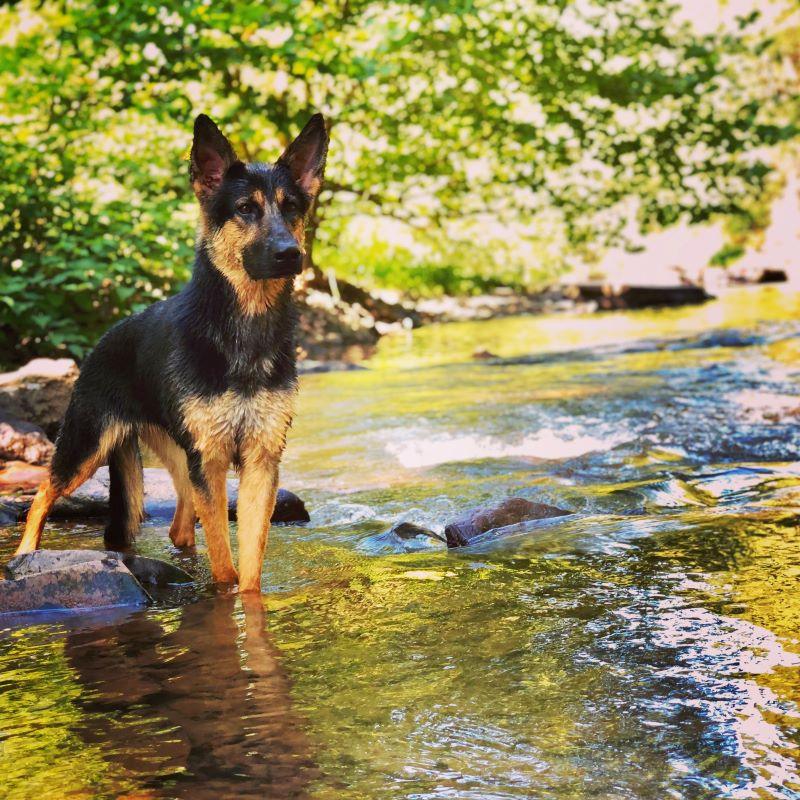If you’ve got a pup who loves the water, one of the most fun summer activities can be getting out there and letting them wade and paddle. Watching them jump and splash can be comical and seeing them swim leisurely along with just their heads and tips of their tails showing can be therapeutic and relaxing!
To ensure that the fun continues, just like with humans, it is important to keep in mind some water safety tips for your dogs.
- Temperature. In some parts of the country, cool temps and chilly water are still a thing – not everyone is in balmy summertime yet. The easiest rule of thumb is the 100 degree gauge. Meaning the water temperature + air temperature must equal at least 100 degrees Fahrenheit before letting your dog swim. If the water temperature is too cold, you risk your dog suffering from swimmer’s tail or hypothermia.
- Water toxicity. Don’t let your dog swallow too much water while swimming. A common sign is coughing or vomiting after swimming. The best prevention is to keep the swimming sessions to 10 minutes or less at a time. Another trick is to avoid throwing large toys in the water – stick with small flat toys like a soft flying disc, which is easier for the dog to grab without taking in too much water.
- Other water critters. If your pup is a fan of ponds, lakes and other natural bodies of water, beware what else may be living in that water. Water snakes, snapping turtles, and even alligators in southern inland coastal waters can pose a threat. A slightly less obvious but serious threat is blue-green algae (also known as cyanobacteria). This bacteria forms on the surface of the water and blooms, creating a green, blue-green or brown-colored scum or foam. Some blue-green algae are highly toxic to dogs. Other bacteria like Leptospira (usually found in warm areas with high rainfall) and Pythiosis (a fungal-like organism that likes warmer climates with plenty of standing water) and Giardiasis all can cause issues from diarrhea to more serious health treats like GI system and kidney issues. Your best option is to let your dog play in clean, clear fresh water and avoid any obvious algae growth or stagnant standing water. If you think your dog may have consumed water with blue-green algae, see your vet as soon as possible.

- For dogs prone to ear infections, one of the most common causes can be found in water: Pseudomonas aeruginosa. That’s a big name for a tiny organism that is associated with chronic ear infections and “swimmer’s ear”; and it is commonly found in ponds and pools. Dogs who spend a lot of time in the water and have floppy ears that trap heat and moisture are at higher risk. The best defense against ear infections is to clean the ears regularly, especially after swimming, with wipes like Silver Honey® Vet Strength Pet Wipes. If your dog exhibits classic signs of otitis externa ear infections like head shaking, ear scratching, oozy discharge, swelling or bad ear odor, start treating with Silver Honey® Vet Strength Ear Treatment to heal quickly and schedule a vet visit.
It is a great idea to give your dog a quick rinse with fresh clean water and dry them off (remember those ears too!) after a swimming adventure. By taking just a few precautions before diving in, you and your dog can enjoy a full summer of splashing fun – because no one wants to sit restrained on the sidelines and miss out on those moments that matter.
Sources:
https://www.petmd.com/dog/slideshows/parasites/7-scary-diseases-your-dog-can-get-water
https://www.vets-now.com/pet-care-advice/dogs-blue-green-algae-poisoning-treatment/





